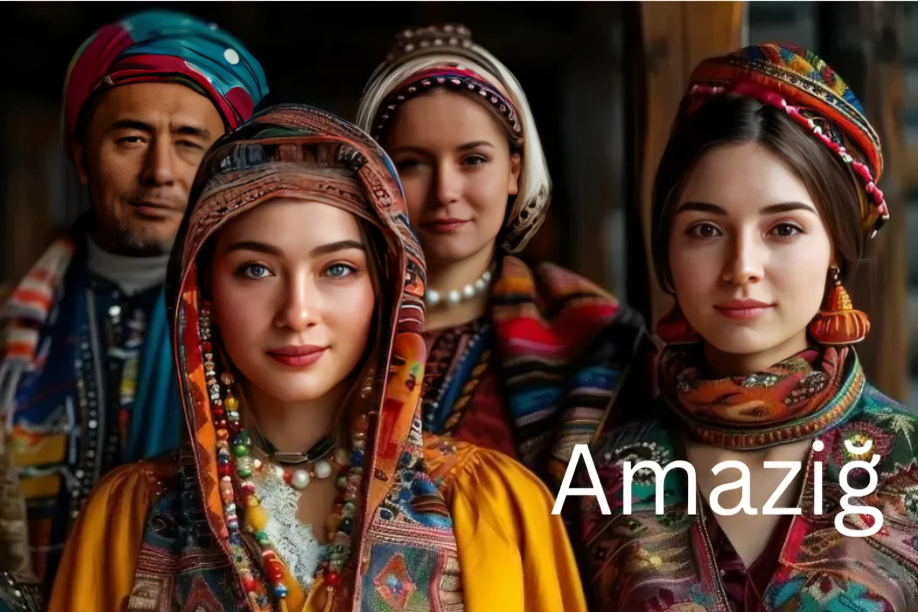
amaziğ
Introduction
In the grand mosaic of world cultures, the Amaziğ people represent a vibrant thread, woven with resilience, creativity, and a profound connection to their land and heritage. This article embarks on a journey through the essence of Amaziğ identity, exploring its significance in the global context.
Definition of “Amaziğ” and its Significance in World Cultures
The term “Amaziğ” refers to an indigenous ethnic group primarily inhabiting North Africa, notably regions such as Morocco, Algeria, Tunisia, Libya, and parts of the Sahara. Their cultural significance transcends geographical boundaries, resonating with the broader narrative of human diversity and resilience. The Amaziğ people, often referred to as Berbers, embody a rich cultural legacy that has withstood the test of time, influencing the social and historical landscape of the region.
Overview of the Amaziğ People and their Historical Background
The Amaziğ, known for their vibrant traditions and deep-rooted connections to their ancestral lands, boast a rich historical tapestry dating back millennia. As one of the oldest indigenous groups in North Africa, their origins intertwine with the region’s ancient civilizations, including interactions with the Phoenicians, Romans, Arabs, and other cultures. This blending of influences has shaped the unique identity of the Amaziğ people, making them integral to the historical narrative of North Africa.
Historical Context
Origins of the Amaziğ People:Unraveling the origins of the Amaziğ people leads us into the misty corridors of antiquity. While precise details remain shrouded in the annals of time, scholars speculate about their ancestral connections to prehistoric inhabitants of North Africa, whose lineage significantly shaped the region’s cultural landscape. Archaeological findings and historical accounts suggest that the Amaziğ people have lived in North Africa for thousands of years, developing a complex society with its own languages, customs, and traditions.
The Amaziğ in Ancient History:Tracing their footprint through antiquity unveils a narrative of resilience and adaptation. From the mighty Carthaginian Empire to the Berber kingdoms of Numidia and Mauretania, the Amaziğ people left an indelible mark on the historical canvas of North Africa. They played crucial roles in the political and military arenas, often resisting external domination while maintaining their cultural identity. The ancient Romans recognized the strategic significance of the Amaziğ territories, resulting in both conflict and collaboration between these two cultures.
Key Historical Events that Shaped the Amaziğ Culture:The Amaziğ journey is punctuated by pivotal moments, including encounters with external forces such as the Roman conquests and Arab invasions, which influenced their language, customs, and societal structures. The arrival of Islam in the 7th century brought about significant changes in the religious landscape of the Amaziğ people, leading to a blend of traditional beliefs and Islamic practices. This syncretism has continued to shape their cultural identity, as the Amaziğ adapted to new influences while striving to preserve their unique heritage.
Language and Literature
The Amaziğ Language: TamazightAt the heart of Amaziğ identity lies the Tamazight language, a linguistic treasure reflecting the nuances of their worldview, history, and cultural ethos. Despite centuries of external pressures, Tamazight persists as a testament to the resilience of its speakers. This language is not merely a means of communication; it embodies the history and traditions of the Amaziğ people, serving as a vital link to their ancestors.
Script and Writing Systems:The evolution of Amaziğ script and writing systems unveils a saga of adaptation and innovation. From ancient Tifinagh, an indigenous script, to contemporary adaptations, the writing systems symbolize the enduring spirit of cultural heritage. The revival of Tifinagh in modern times, especially in educational settings, signifies a growing appreciation for the Amaziğ language and its importance in preserving their identity.
Oral Traditions and Storytelling:Embedded within the fabric of Amaziğ society is a rich tradition of oral storytelling, serving as a conduit for transmitting collective wisdom, legends, and historical narratives across generations. These stories often revolve around themes of bravery, nature, and the interconnectedness of the Amaziğ people with their environment. Storytelling sessions are communal events, fostering a sense of unity and shared identity among the Amaziğ.
Contributions to Literature and Poetry:Amaziğ literature and poetry form a kaleidoscope of emotions, aspirations, and societal reflections, offering insights into their worldview, struggles, and aspirations. Through their literary expressions, Amaziğ writers articulate their experiences and challenges, contributing to the broader discourse on identity, resilience, and cultural preservation in a rapidly changing world.
Art and Music
Traditional Amaziğ Art Forms:From intricate textile designs to vibrant ceramics, traditional Amaziğ art forms encapsulate a synergy of aesthetics and cultural symbolism, mirroring the diversity and resilience of their heritage. The craftsmanship displayed in their art often tells stories of their history, spirituality, and connection to the land. Artisans meticulously create pieces that reflect both personal and communal narratives, showcasing the skills passed down through generations.
Significance of Tattoos and Symbols:Tattoos and symbolic motifs hold a sacred place in Amaziğ culture, embodying ancestral connections, spiritual beliefs, and personal narratives woven into the tapestry of skin and soul. These markings often signify significant life events, family heritage, and social status, reinforcing the individual’s connection to their community and identity. In recent years, there has been a resurgence in the appreciation of traditional tattooing practices among younger generations.
Music and Dance in Amaziğ Culture:The rhythmic beats of Amaziğ music echo through time, evoking a sense of collective identity and celebration. Traditional music often accompanies cultural events, weddings, and festivals, serving as a vital expression of joy and communal bonding. The vibrant dances that accompany the music further animate gatherings, showcasing the shared history and cultural pride of the Amaziğ people.
Famous Amaziğ Artists and Musicians:Across the annals of history, Amaziğ artists and musicians have carved their niche in the global cultural landscape, their works resonating with universal themes of love, longing, and liberation. Contemporary artists continue to draw inspiration from their rich heritage, blending traditional elements with modern influences to create a dynamic cultural expression that resonates with audiences worldwide.
Social Structure and Daily Life
Family and Community Life:At the nucleus of Amaziğ society lies the family unit, characterized by strong kinship ties, communal solidarity, and a shared sense of responsibility towards one another. Families often gather to celebrate milestones and support one another during challenging times, reinforcing the values of mutual aid and cooperation. This communal spirit is vital for the Amaziğ, providing a sense of belonging and identity.
Gender Roles and Societal Norms:Amaziğ societal norms reflect a nuanced interplay between tradition and modernity, with gender roles evolving amidst shifting cultural paradigms and socio-economic dynamics. While traditional roles have historically placed men as providers and women as caregivers, contemporary shifts are challenging these norms, allowing for greater gender equality and empowerment. Women are increasingly participating in education, entrepreneurship, and leadership roles within their communities.
Traditional Clothing and Attire:The attire of the Amaziğ people serves as a visual tapestry, woven with intricate patterns, vibrant hues, and symbolic motifs that encapsulate their cultural identity and heritage. Traditional clothing often varies by region, showcasing the diversity within the Amaziğ community. These garments are not only functional but also carry deep cultural significance, often worn during celebrations and rituals.
Culinary Traditions and Typical Dishes:The culinary traditions of the Amaziğ people offer a delectable journey into their heritage, characterized by an array of aromatic spices, hearty stews, and savory pastries that tantalize the senses and nourish the soul. Dishes such as couscous and tagine reflect a blend of local ingredients and culinary techniques, symbolizing the Amaziğ’s connection to their land and agricultural practices. Food serves as a central element of social gatherings, fostering community bonds and shared experiences.
Spiritual Beliefs and Practices
Overview of Amaziğ Religious Beliefs:Amaziğ spirituality encompasses a rich tapestry of beliefs, drawing inspiration from ancestral reverence, animism, and syncretic interactions with monotheistic faiths such as Islam. This spiritual landscape is marked by a deep respect for nature, ancestral spirits, and the divine, influencing daily practices and communal rituals.
Rituals and Ceremonies:Rituals and ceremonies play a pivotal role in Amaziğ spiritual life, serving as occasions for community bonding, ancestral homage, and seeking divine blessings for prosperity and protection. Events such as weddings, harvest festivals, and religious observances bring the community together, reinforcing cultural values and shared identity.
Role of Spirituality in Daily Life:Spirituality permeates every facet of Amaziğ daily life, infusing mundane activities with profound meaning, mindfulness, and a sense of interconnectedness with the natural world. This holistic approach to spirituality fosters a deep appreciation for the land and its resources, encouraging sustainable practices that respect the environment.
Amaziğ People Today
The Modern Amaziğ Identity:In the contemporary landscape, the Amaziğ people navigate a complex terrain of cultural preservation, socio-economic challenges, and aspirations for self-determination. They forge a modern identity rooted in ancestral pride and resilience, seeking to maintain their cultural heritage while engaging with the broader global community. This balancing act reflects their commitment to honoring their roots while adapting to the demands of modern life.
Challenges Faced by the Amaziğ Community:Despite strides toward recognition and cultural revival, the Amaziğ community grapples with enduring challenges, including marginalization, linguistic discrimination, and socio-economic disparities. Efforts to promote their language and cultural rights often face resistance, highlighting the ongoing struggle for recognition and equality.
Advocacy for Amaziğ Rights and Recognition:Across North Africa and beyond, advocacy movements have emerged to champion the rights and recognition of the Amaziğ people. Activists, scholars, and community leaders strive to raise awareness about the cultural significance of the Amaziğ, demanding equitable representation in political, educational, and social spheres. These efforts contribute to a broader discourse on indigenous rights and cultural diversity.
Contributions to Global Culture:The Amaziğ people’s rich cultural heritage and contemporary expressions resonate far beyond their geographical borders, enriching global culture with their artistry, music, and philosophy. As they share their stories and traditions, they contribute to a collective understanding of humanity’s diversity, fostering empathy and appreciation for cultural uniqueness in an increasingly interconnected world.
Conclusion
Recap of the Importance of Amaziğ Culture:The Amaziğ culture stands as a testament to the resilience of indigenous peoples worldwide, showcasing the richness of human diversity. Through their language, art, spirituality, and social practices, the Amaziğ people illuminate the profound connections between identity, heritage, and community. Their journey reflects not only their struggles and triumphs but also the universal quest for belonging and recognition.
Final Thoughts on the Future of Amaziğ Heritage
As the Amaziğ people navigate the complexities of the modern world, their commitment to preserving their cultural heritage remains unwavering. By fostering intergenerational dialogue, advocating for their rights, and embracing the beauty of their traditions, they continue to inspire a shared vision of cultural preservation and appreciation. The future of Amaziğ heritage lies in the hands of its people, a vibrant tapestry of stories waiting to be told, cherished, and celebrated for generations to come.
FAQs
1. What does the term “Amaziğ” mean?
The term “Amaziğ” refers to an indigenous ethnic group primarily inhabiting North Africa, particularly in regions like Morocco, Algeria, Tunisia, and Libya. It represents a rich cultural heritage and identity that has endured through centuries.
2. What are the main characteristics of Amaziğ culture?
Amaziğ culture is characterized by its unique language (Tamazight), traditional art forms, music, oral storytelling, and deep spiritual beliefs. The community emphasizes family bonds, communal solidarity, and a profound connection to the land.
3. How does the Amaziğ language contribute to their identity?
The Amaziğ language, Tamazight, is a crucial element of their identity, embodying their history, traditions, and worldview. It serves as a means of communication and cultural expression, connecting generations and preserving their heritage.
4. What role does art play in Amaziğ culture?
Art in Amaziğ culture encompasses various forms, including textiles, ceramics, and traditional tattoos. These art forms not only showcase aesthetic beauty but also convey cultural significance, often telling stories of ancestry and community.
5. How do modern challenges affect the Amaziğ community?
The Amaziğ community faces challenges such as marginalization, linguistic discrimination, and socio-economic disparities. Advocacy efforts are ongoing to promote their cultural rights, recognition, and equitable representation in society.
6. What are some traditional Amaziğ dishes?
Traditional Amaziğ cuisine includes dishes like couscous, tagine, and various hearty stews. Their culinary traditions reflect a blend of local ingredients and cultural practices, often served during communal gatherings and celebrations.
7. How can I learn more about Amaziğ culture?
To learn more about Amaziğ culture, you can explore academic resources, documentaries, and cultural events celebrating their heritage. Engaging with Amaziğ communities through workshops or cultural festivals can also provide deeper insights.
8. What efforts are being made to preserve Amaziğ heritage?
Efforts to preserve Amaziğ heritage include promoting the Tamazight language in education, celebrating traditional arts and crafts, and advocating for cultural rights. Community leaders and activists work towards ensuring that Amaziğ culture remains vibrant and recognized.
Uncover juicy celebrity rumors and entertainment updates on chicagoreader.






